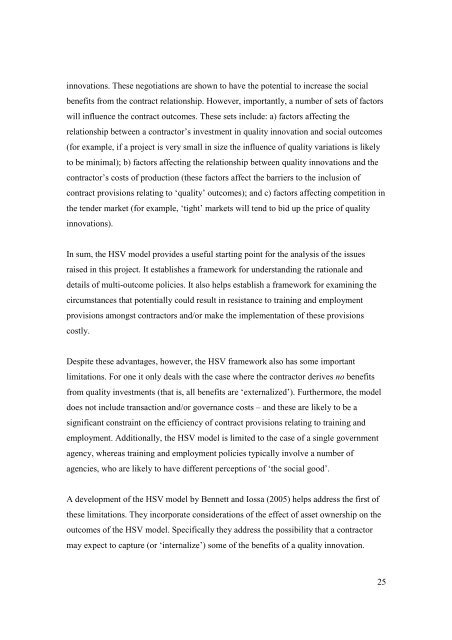Multi Outcome Construction Policy (final report)
Multi Outcome Construction Policy (final report)
Multi Outcome Construction Policy (final report)
You also want an ePaper? Increase the reach of your titles
YUMPU automatically turns print PDFs into web optimized ePapers that Google loves.
innovations. These negotiations are shown to have the potential to increase the socialbenefits from the contract relationship. However, importantly, a number of sets of factorswill influence the contract outcomes. These sets include: a) factors affecting therelationship between a contractor’s investment in quality innovation and social outcomes(for example, if a project is very small in size the influence of quality variations is likelyto be minimal); b) factors affecting the relationship between quality innovations and thecontractor’s costs of production (these factors affect the barriers to the inclusion ofcontract provisions relating to ‘quality’ outcomes); and c) factors affecting competition inthe tender market (for example, ‘tight’ markets will tend to bid up the price of qualityinnovations).In sum, the HSV model provides a useful starting point for the analysis of the issuesraised in this project. It establishes a framework for understanding the rationale anddetails of multi-outcome policies. It also helps establish a framework for examining thecircumstances that potentially could result in resistance to training and employmentprovisions amongst contractors and/or make the implementation of these provisionscostly.Despite these advantages, however, the HSV framework also has some importantlimitations. For one it only deals with the case where the contractor derives no benefitsfrom quality investments (that is, all benefits are ‘externalized’). Furthermore, the modeldoes not include transaction and/or governance costs – and these are likely to be asignificant constraint on the efficiency of contract provisions relating to training andemployment. Additionally, the HSV model is limited to the case of a single governmentagency, whereas training and employment policies typically involve a number ofagencies, who are likely to have different perceptions of ‘the social good’.A development of the HSV model by Bennett and Iossa (2005) helps address the first ofthese limitations. They incorporate considerations of the effect of asset ownership on theoutcomes of the HSV model. Specifically they address the possibility that a contractormay expect to capture (or ‘internalize’) some of the benefits of a quality innovation.25
















